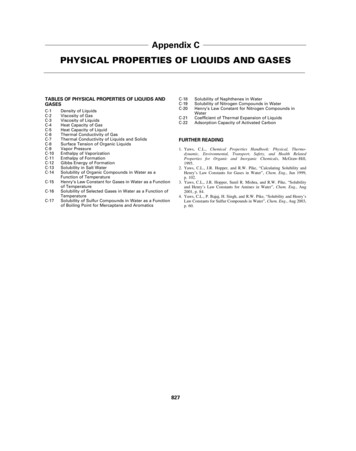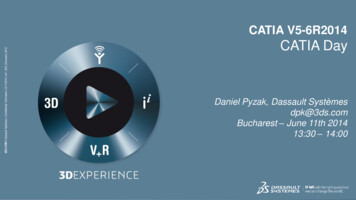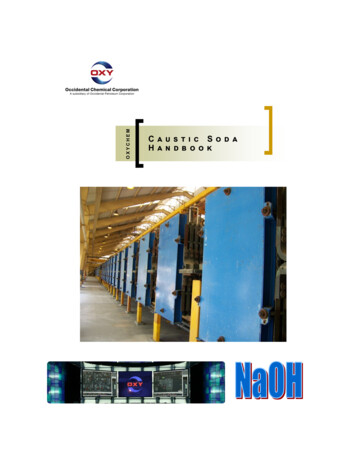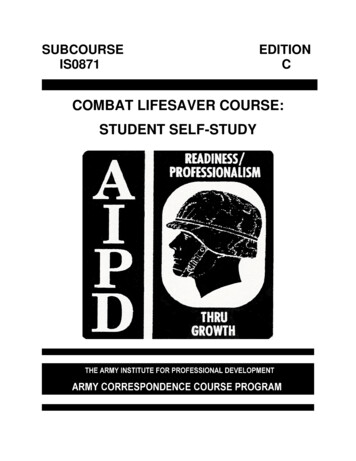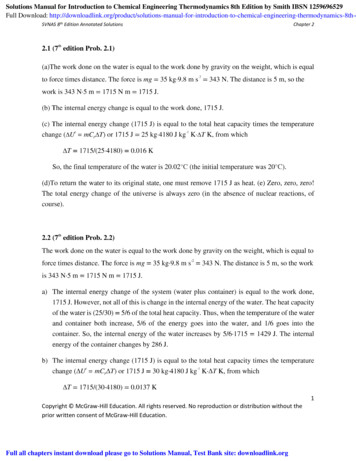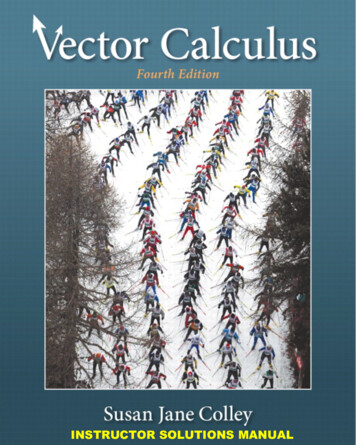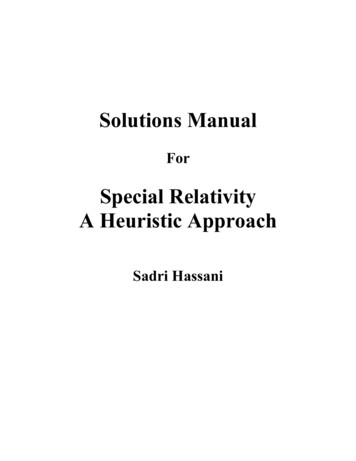
Transcription
Solutions ManualForSpecial RelativityA Heuristic ApproachSadri Hassani
ContentsList of Symbols11 Qualitative Relativity52 Relativity of Time and Space93 Lorentz Transformation194 Spacetime Geometry495 Spacetime Momentum756 Relativity in Four Dimensions857 Relativistic Photography998 Relativistic Interactions1279 Interstellar Travel13910 A Painless Introduction to Tensors15111 Relativistic Electrodynamics15712 Early Universe167A Maxwell’s Equations177B Derivation of 4D Lorentz transformation181C Relativistic Photography Formulas185
List of Symbols, Phrases, and Acronymsâ unit vector in the direction of aanti-particle a particle whose mass and spin are exactly the same as its correspondingparticle, but the sign of all its “charges” are opposite. If a particle is representedby the letter p, then it is customary to denote its anti-particle by p̄. If a particle isrepresented by the letter q (or q ), then it is customary to denote its anti-particleby q (or q ).as arcsecond; an arcsecond is an angle 1/3600 of a degree.baryon a hadron whose spin is an odd multiple of /2. Baryons are composed of threequarks. Examples of baryons are protons and neutrons. fractional velocity of one observer relative to another, β v /cβboson a particle whose spin is an integer multiple of . All gauge particles are bosons asare all mesons, as well as the Higgs particle.causally connected referring to two two events. If an observer or a light signal can bepresent at two events, those events are said to be causally connected.causally disconnected referring to two two events. If an observer or a light signal cannotbe present at two events, those events are said to be causally disconnected.CBR Cosmic Background RadiationCM center of massCS coordinate systemêx , êy , êz unit vectors along the three Cartesian axes.EM electromagnetic or electromagnetism, one of the four fundamental forces of nature.equilibrium temperature temperature of the universe at which matter and radiationdensities are equaleV electron volt, unit of energy equal to 1.6 10 19 J
2List of Symbolsfermion a particle whose spin is an odd multiple of /2. Fermions obey Pauli’s exclusionprinciple: no two identical fermions can occupy a single quantum state. Electrons,protons, and neutrons are fermions, so are all leptons and quarks, as well as allbaryons.ppγ the Lorentz factor, γ 1/ 1 β 2 1/ 1 (v/c)2gauge bosons According to the modern theory of forces, fundamental particles interactvia the exchange of gauge bosons. Excluding gravity, whose microscopic behavioris not well understood, there are 12 gauge bosons whose exchange explains all theinteractions: Z 0 , W and γ (photon) are responsible for electroweak interaction,while 8 gluons are responsible for strong interaction.gluons the particles responsible for strong interactions: two or more quarks participatein strong interaction by exchanging gluons. There are four gluons, which with theirantiparticles comprise the eight gluons whose exchange binds quarks together.GTR general theory of relativity; the relativistic theory of gravity.Gyr gigayear, equal to 109 yearshadron a particle capable of participating in strong nuclear interactions. Examples ofhadrons are protons, neutrons and pions. All hadrons are made up of quarks and/oranti-quarks.half life the time interval in which one half of the initial decaying particles survive.LAV Law of Addition of Velocitieslepton a particle that participates only in electromagnetic and weak nuclear interactions,but not in strong nuclear interactions. Leptons are elementary particles in the sensethat they are not made up of anything more elementary. There are three electrically charged leptons: electron, muon, and tauon. Each charged lepton has its ownneutrino. So, altogether there are six leptons.LHC Large Hadron Colliderlight cone (at an event E) The set of all events that are causally connected to E.light hour the distance that light travels in one hour, 1.08 1012 mlight minute the distance that light travels in one minute, 1.8 1010 mlight second the distance that light travels in one second, 3 108 mlightlike referring to two events, when c t x or ( s)2 0.luminally connected referring to two two events. If a light signal can be present at twoevents, those events are said to be luminally connected.ly light year; one light year is 9.467 1015 m.mean time the time interval in which 1/e of the initial decaying particles survive.
List of Symbolsmeson a hadron whose spin is an integer multiple of . Mesons are composed of one quarkand one anti-quark. Examples of mesons are pions.MeV million electron volt, unit of energy equal to 1.6 10 13 Jµm micrometer 10 6 mMinkowskian distance also called “spacetime distance,”( s)2 (c t)2 ( x)2is an expression involving the coordinates of two events which is independent of thecoordinates used to describe those events.MM clock sometimes called “light clock” is described on page 13.Mpc Megaparsecmuon an elementary particle belonging to the group of particles named “leptons,” to whichelectron belongs as well. Muon is called a “fat electron” because it behaves very muchlike an electron except that it is heavier.neutrino a neutral lepton with very small mass. Neutrinos participate only in weak nuclearforce. That’s why they are very weakly interacting.ns nanosecond or 10 9 sParsec A distance of about 3.26 light years. One parsec corresponds to the distance atwhich the mean radius of the Earth’s orbit subtends an angle of one second of arc.positron the anti-particle of the electronquarks elementary particles which make up all hadrons. There are six quarks: up, down,strange, charm, bottom, top. Quarks participate in all interactions, in particular, thestrong interaction.RF reference framespacelike referring to two events, when c t x or ( s)2 0.spacetime distance see Minkowskian distanceSTR special theory of relativitytauon an elementary particle belonging to the group of particles named “leptons,” to whichelectron belongs as well. It is the heaviest lepton discovered so far.timelike referring to two events, when c t x or ( s)2 0.3
CHAPTER1Qualitative RelativityProblems With Solutions1.1. A rod of length L emits light from all of its points simultaneously (in its rest frame)when a remote switch is turned on. Its center is on the x-axis and is moving on the axis ina plane parallel to a very large photographic plate and infinitesimally close to it. When itreaches the middle of the plate, the switch is turned on.(a) Compare the length L of the image on the photographic plate with L when the rodis along the x-axis: L L, L L, or L L? Give a reason for your answer.(b) Compare the length L of the image on the photographic plate with L when the rodis perpendicular to the x-axis: L L, L L, or L L? Give a reason for youranswer.Solution:(a) Length parallel to the direction of motion shrinks regardless of who sees the eventsof light emission simultaneously. See the discussion in Section 1.3 for the reason (aswell as how to capture the length of a moving object).(b) Length perpendicular to the direction of motion does not change.Note the importance of the fact that the distance between the rod and the photographicplate is zero. 1.2. A rod is placed along the x-axis with its center at the origin. A pinhole camera C1 islocated on the z-axis and takes a picture of the stationary rod. Now the rod starts movingalong the x-axis parallel to itself from . Camera C1 is removed and another pinholecamera C2 replaces it on the z-axis. As soon as the center of the rod reaches the origin(call it t 0), C2 takes a picture.(a) Is the pinhole of C2 collecting the light rays from the two ends of the rod that wereemitted at t 0?
6Qualitative Relativity(b) Is the pinhole collecting the light rays from the two ends of the rod that were emittedsimultaneously, but not at t 0?(c) If the answer to (b) is no, which end emitted its light first, the trailing end or theleading end?(d) Is it possible for the image of the rod in C2 to be longer than its image in C1 ? Hint:Consider the location of each end as it emits the light ray captured by C2 .Solution:(a) No. It takes time for the light to reach the camera once it leaves its source.(b) No.(c) The trailing end is farther away from the camera, so it must emit the light soonerthan the leading end.(d) The trailing end emits its light, the rod moves a little, then the leading end emits itslight. So, the distance between the source of the light from the trailing end and thatof the leading end is indeed larger than the length of the rod.Note that the image in camera C2 , which is longer than the image in C1 , has nothing to dowith the actual length of the rod! 1.3. A rod is placed along the y-axis with its center at the origin. A pinhole camera C1 islocated on the z-axis and takes a picture of the stationary rod. Now the rod starts movingalong the x-axis parallel to itself from . Camera C1 is removed and another pinholecamera C2 replaces it on the z-axis. As soon as the center of the rod reaches the origin(call it t 0), C2 takes a picture.(a) Is the pinhole of C2 collecting the light rays from the two ends of the rod that wereemitted at t 0?(b) Is the pinhole collecting the light rays from the two ends of the rod that were emittedsimultaneously, but not at t 0?(c) If the answer to (b) is no, which end emitted its light first, the top or the bottom?(d) Is it possible for the image of the rod in C2 to be longer than its image in C1 ? Hint:Consider the locations of the ends as they emit their light rays captured by C2 , thedistance between those locations and the pinhole, and the angle they subtend at thepinhole.Solution:(a) No. It takes time for the light to reach the camera once it leaves its source.(b) Yes. The perpendicular distance does not change. So, the top and bottom of the rodare equidistant from the pinhole, and to reach it at t 0, the rays must have beenemitted at the same time in the past.(c) The answer to (b) is yes!
7(d) No. Since the locations of the sources of the rays are farther from C2 (they havenegative x-coordinates) than the locations in C1 , they must have a smaller image.Chapter 7 discusses this in gory mathematical detail! 1.4. A circular ring emits light from all of its points simultaneously (in its rest frame) whena remote switch is turned on. It is moving in a plane parallel to a photographic plate andinfinitesimally close to it. When it reaches the plate, the switch is turned on. What is theshape of the image of the photograph? Hint: See Problem 1.1.Solution: The diameter along the direction of motion shrinks; the diameter perpendicularto the direction of motion stays the same. So, the shape is an ellipse flattened in thedirection of motion. 1.5. A conveyor belt moving at relativistic speed carries cookie dough. A circular stampcuts out cookies as the dough rushes by beneath it. What is the shape of these cookies?Are they flattened in the direction of the belt, stretched in that direction, or circular?Solution: The answer is identical to that of the previous problem. So, the cookies areflattened in the direction of the belt. 1.6. A conveyor belt moving at relativistic speed carries cookie dough. A laser gun onemeter above the belt emits a beam in the shape of the surface of a circular cone thatcuts the dough perpendicularly. Are these cookies flattened in the direction of the belt,stretched in that direction, or circular? Hint: Concentrate on the two ends of the diameterof the beam along the dough, and note that their light beams arrive simultaneously at thestationary bed on which the dough is moving. Now consider how the two events appearin the RF of the moving dough and what implication it has on the length of the diameter.The discussion surrounding Figure 1.3 may be helpful.Solution: The image of the laser beam on the stationary bed is circular and the twoevents of the arrival of the beams from the two ends of the horizontal diameter occursimultaneously. Consider two experiments. In the first experiment, there is no dough andthe laser imprints a circle on the stationary bed. In the second experiment, an observerriding with the dough records the coincidence of the location of the event in front of herwith the front end of the imprint before the coincidence of the event in the back. Sheconcludes that for her, the distance between the two events is larger than the two markson the stationary bed. So, the image is an ellipse elongated along the direction of the belt.Thus, the cookies are stretched in the direction of the belt. 1.7. A circular ring is centered at the origin in the xy-plane. A pinhole camera C1 is locatedon the z-axis and takes a picture of the stationary ring. Now the ring starts moving alongthe x-axis from . Camera C1 is removed and another pinhole camera C2 replaces it onthe z-axis. As soon as the center of the rod reaches the origin (at t 0), C2 takes a picture.(a) Is the pinhole of C2 collecting the light rays from the two ends of the horizontaldiameter (along the x-axis) of the ring that were emitted at t 0? Hint: Look atProblem 1.2.(b) Is the pinhole of C2 collecting the light rays from the two ends of the horizontaldiameter of the ring that were emitted simultaneously, but not at t 0?
8Qualitative Relativity(c) If the answer to (b) is no, which end emitted its light first, the trailing end or theleading end?(d) Is it possible for the image of the horizontal diameter in C2 to be longer than itsimage in C1 ?(e) Is the image of the vertical diameter (along the y-axis) in C2 equal to, longer than,or shorter than its image in C1 ? Hint: Look at Problem 1.3.(f) Can you guess what the shape of the image of the ring is in C2 ?Solution:(a) No.(b) No.(c) The trailing end.(d) Yes, it always is.(e) It is shorter than its image in C1 .(f) It is an ellipse elongated along the direction of motion.See Example 2.2.6 for a quantitative analysis of this problem.
CHAPTER2Relativity of Time and SpaceProblems With Solutions2.1. Take the most rigid rod you can find, and hit one end of it with the hammer. Therod as a whole starts to move because it is rigid.1 Actually not! It takes time for theinformation that one end of the rod was hit to reach the other end, because of Note 2.1.7.Now go to the rest frame of the rod which is now moving relative to the hammer. Assumethat the hammer hits the rod in such a way as to cause (the front end of) it to stop. Butthe other end knows nothing about the hammer yet. So, it keeps moving! What does thissay about the concept of “rigidity” in relativity?Solution: Rigidity is not a well defined concept in relativity. The other end of the rod getscompressed because of its motion. 2.2. In this problem you’ll learn more about superluminal transverse speeds.(a) Show that the angle that maximizes Equation (2.6) is given by cos θ β.(b) Substitute this in (2.6) to obtain (vtr )max cβγ. (c) Show that (vtr )max is larger than c for any β 1/ 2.(d) What speed makes (vtr )max ten times faster than light? What is the angle corresponding to this speed?Solution:(a) Set the derivative of vtr0vtr(θ) cβ(cos θ β)(β cos θ 1)200 (θ) 0 whenequal to zero to get cos θ β. The second derivative test shows that vtrcos θ β. Therefore, vtr is indeed maximum at cos θ β.1If you hit one end of a slinky, the other end does not move, at least not immediately.
10Relativity of Time and Space(b)(vtr )maxpsin θ1 β2cβ cβγ. cβ cβ p21 β cos θ1 β1 β2(c)cβγ c β 2 γ 2 1 β 2 1 β 2 β 2 1/2.(d)βγ 10 β 2 γ 2 100 β 2 100 100β 2 β 2 100/101,or if β 0.995. The angle corresponding to this β is θ cos 1 0.995 0.0997 orθ 5.71 . 2.3. Consider an MM clock moving horizontally with speed β relative to observer O. Denoteits length in motion by L and at rest by L0 . Let t1 be the time it takes light to go fromthe emitter to the mirror according to O. Let t2 be the time it takes light to go from themirror to the emitter according to O.(a) Show thatc t1 L βc t1 ,c t2 L βc t2 .(b) Show that a “tick” according to O is t t1 t2 2L/c.1 β2(c) Now use the time dilation formula with τ 2L0 /c to derive the length contractionformula.Solution:(a) By the time the light that is emitted at the emitter reaches the mirror, the MM clockhas moved. So, the distance that the light covers is L plus the distance that the MMclock moves in the same time interval. So, c t1 L βc t1 , andc t1 (1 β) L t1 L.c(1 β)On reflection, the light and the MM clock move in opposite directions. Therefore,c t2 L βc t2 , andc t2 (1 β) L t2 L.c(1 β)(b) A tick according to O is therefore, t t1 t2 LL2L/c .c(1 β) c(1 β)1 β2But t γ τ γ(2L0 /c). Thus,γ(2L0 /c) p2L/c γ 2 (2L/c) L L0 /γ L0 1 β 2 .21 β
112.4. The spaceship Enterprise goes to a planet in a star system far away with a speed of0.9c, spends 6 months on the planet, and comes back with a speed of 0.95c. The entire triptakes 5 years for the crew.(a) How far is the planet according to Earth observers?(b) How long did it take the crew to get to the planet?(c) How long did the entire trip take for the Earth observers?Solution: (a) On the outbound part, the distance for the crew is L0 1 0.92 and the time it takesthem to get there is L0 1 0.92 /(0.9c), where L0 is the distance according to Earthobservers. Similarly, the time it takes them to come back is L0 1 0.952 /(0.95c).So, the entire round trip time is L0 1 0.92 L0 1 0.952 4.5 years.0.9c0.95cThis gives L0 5.54 light years.(b) τoutbound L0 1 0.92 0.484 years. 0.9c(c) The distance according to Earth is 5.54 light years. So, for outbound trip toutbound 5.54 light years 6.15 years.0.9cSimilarly,5.54 light years 5.83 years.0.95cTherefore the entire trip takes 6.15 0.5 5.83 12.48 years. tinbound 2.5. A rocket ship leaves the Earth at a speed of 0.8c. When a clock on the rocket says 1hour has elapsed, the rocket ship sends a light signal back to Earth.(a) According to Earth clocks, when was the signal sent?(b) According to Earth clocks, how long after the rocket left did the signal arrive backon Earth?(c) According to the rocket clock, how long after the rocket left did the signal arrive backon Earth?Solution:(a) The rocket is measuring the proper time of 1 hour. So, for Earth1 hour t γ τ 1.67 hours.1 0.82
12Relativity of Time and Space(b) The distance of the rocket from Earth when it sends the signal is1.67 hours 0.8c 1.33 light hours.So, it took 1.33 hours for the signal to arrive at Earth after it was sent. Therefore,between the rocket leaving and the signal arriving, it took 1.33 1.67 3 hoursaccording to Earth. Note that this is proper time for Earth.(c) The rocket measures coordinate time:3 hour trocket 5 hours.1 0.82It is a good exercise to find the answer to (c) by calculating in the rocket frame. Note thatthe Earth moves at 0.8c away from the rocket. So, when the rocket sends the signal, theEarth is at a distance of 0.8 light hour from rocket. Now the rocket sends a signal thatchases the Earth. When does the light catch up with Earth according to rocket? 2.6. A bicycle wheel of rest radius R is rotating in such a way that the rim has a linearspeed of 0.866c. What is the circumference of the rim? What is the length of the spokesin motion? But spokes are perpendicular to the direction of motion! Discuss whether inrelativity anything can be considered “incompressible” or “rigid.” See also Problem 2.1.Solution: For the same reason as Problem 2.1, the spokes are not “rigid.” 2.7. The spaceship Viking goes to a planet in a star system 30 light years away from Earthwith a speed of 0.99c, spends 1 year on the planet, and then returns home. The entire triptakes 10 years for the crew.(a) How far is the planet according to crew?(b) How long does it take the crew to get to the planet?(c) How long does it take the crew to return to Earth?(d) What is the speed of the crew on return? Warning! The distance for the crew is notthe same as the distance on their way to the planet.(e) How far is the Earth from the planet according to crew on their return?(f) How long did the entire trip take for the Earth observers?Solution: (a) L 30 1 .992 4.23 light years.(b) The distance is 4.23 light years, and they are going at 0.99c, so it takes them 4.23/0.99,or 4.27 years to get there.(c) Since the entire trip is 10 years, the return time is 10 4.27 1 4.73 years.
13p2(d) Let β2 be the speed of return.pThen the distance is 30 1 β2 light years. And the2time, in terms of speed, is 30 1 β2 /cβ2 . So, we have to solve the equationp30 1 β22 light years 4.73 years.cβ2The answer comes out to be β2 0.988. (e) L 30 1 0.9882 4.67 light years.(f)30 light years30 light years 1 61.67 years.0.99c0.988c 2.8. The spaceship Diracus goes to a planet in a star system with a speed whose Lorentzfactor is γ, spends 1 year on the planet, and then returns home with a speed whose Lorentzfactor is 4γ. The captain of the spaceship is 29 years old and has just had a newborn son.The entire trip takes 11 years for the crew. The odometer of the spaceship shows that the“milage” for the round trip is a quarter of the Earth-planet distance as measured by Earthobservers.(a) What is the outbound speed? The inbound speed?(b) What is the Earth-planet distance according to the Earth observers?(c) What is the Earth-planet distance according to the crew on their way to the planet?On their way back?(d) How long does it take the crew to go to the planet? To return?(e) Who is older, the son or the father when the ship lands on Earth? By how manyyears?Solution:(a) Let L0 be the distance according to Earth. ThenL0 L0L0 .γ4γ4This gives γ 5 andβoutandp γ2 124 0.98,γ5p (4γ)2 1399βin 0.9987,4γ20(b) The round trip time is 10 years. So,Lout LinL0 /γ L0 /(4γ) 10βoutβinβoutβinorL0L0 10.5 0.98 20 0.9987This gives L0 39.35 light years.
14Relativity of Time and Space(c) Lout L0 /γ 7.87 light years; Lin L0 /(4γ) 1.97 light years.(d) τout Lout /cβout 8.03 years; τin Lin /cβin 1.97 years; and these two answersare consistent with the roundtrip time being 10 years.(e) tout L0 /cβout 40.15 years; tin L0 /cβin 39.4. So, the son is 40.15 1 39.4 80.55 years old, while the father is just 29 11 40 years old. 2.9. A rod of rest length L0 moves with speed v along the positive x0 -direction of observerO0 . The rod makes an angle θ0 with respect to the x-axis of its rest frame.(a) Find the length of the rod as measured by O0 .(b) Find the angle θ the rod makes with the x0 -axis as measured by O0 .Solution: The projections along the axes in the rest frame are x L0 cos θ0 , y L0 sin θ0 .In the O0 frame, we havepp x0 x 1 (v/c)2 L0 1 (v/c)2 cos θ0 , y 0 L0 sin θ0(a) The length in O0 isqp( x0 )2 ( y 0 )2 L20 [1 (v/c)2 ] cos2 θ0 L20 sin2 θ0p L0 1 β 2 cos2 θ0 , β v/c.L Note that the answer is consistent with the special cases θ0 0 and θ0 π/2.(b)p1 β 2 cos θ0 x0cos θ0cos θ p p22L1 β cos θ0γ 1 β 2 cos2 θ0ortan θ y 0sin θ0 p γ tan θ0 .0 x1 (v/c)2 cos θ0 2.10. A flasher produces a flash of light every second when at rest. It is moving away fromyou at 0.9c.(a) How frequently does it flash according to you?(b) By how much does the distance between you and the flasher increase between consecutive flashes?(c) How long after the emission of a given flash does it reach you?(d) How often do you receive the flashes?Solution: The flasher keeps proper time.
15(a) t 1s 2.294 s.1 0.92(b) x 0.9c 2.294 s 2.065 light second.(c) From its emission, it takes the flash 2.065 seconds to reach you.(d) The time intervals between flashes is the sum of the time interval between emissionsand the time it takes the flashes to reach you: 2.294 2.065 4.35 seconds.Note that this is related to Doppler effect: Think of a flash as a wavefront. 2.11. Charged pions are produced in many collisions in accelerators. They decay in theirrest frame according toN (t) N0 e t/T ,where T 2.6 10 8 s is their mean life. A burst of charged pions is produced at the targetof an accelerator and it is observed that only one percent of them decay at a distance of1 m from the target. What is the Lorentz factor for pions and how fast are they moving?Solution: Note that t in the decay formula is proper time. So, we have to calculate thingsin the rest frame of the pions. The the distance in the rest frame is L0 /γ. Therefore,t L0 /(γcβ), and0.99 e t/T e L0 /(γcβT ) ln(0.99) pL0L0 γβ γ 2 1 .γcβTln(0.99)cTThis gives γ 12.795 and β 0.997. 2.12. Derive Equations (2.8), (2.9), and (2.10).Solution: Since xc 0, the negative sign in the previous equation must be chosen. Theexpression under square root sign can be written as β 2 γ 2 (β 2 L2 b2 L2 /γ 2 ) β 2 γ 2 b2 L2 β 2 1 β 2 β 2 γ 2 (b2 L2 )This yields (2.8). For (2.9), we have2xA xc L/γ β γL βγpb2 L2 pL222 L/γ γ β L 2 β b L .γEquation (2.9) now follows immediately from the definition of γ in terms of β. Finally, 2ppc2 t2A γ 2 L β b2 L2 b2 γ 2 L2 γ 2 β 2 (b2 L2 ) 2γ 2 βL b2 L2 b2p γ 2 L2 (γ 2 1)b2 γ 2 β 2 L2 2γ 2 βL b2 L2 b2p γ 2 (L2 b2 ) γ 2 β 2 L2 2γ 2 βL b2 L2hi 2pp γ 2 (L2 b2 ) β 2 L2 2βL b2 L2 γ 2 βL b2 L2 .When taking the square root, the negative sign is chosen because the light from A wasemitted in the past.
16Relativity of Time and Space2.13. Derive Equations (2.11) and (2.12).Solution: Just as in the case of A, writepp(x0c L/γ)2 b2 x0c x0c β (x0c L/γ)2 b2 .vcSquaring both sides givesx0c2 β 2 (x0c2 L2 /γ 2 2x0c L/γ b2 ) x0c2 2β 2 L 0 xc β 2 (b2 L2 /γ 2 ) 0.γ2γSolve this quadratic equation for xc to obtainpx0c β 2 γL β 4 γ 2 L2 β 2 γ 2 (b2 L2 /γ 2 ).The negative sign must be chosen because x0c 0. The rest of the solution is identical tothe previous problem. In fact, all the answers are obtained from that problem by changingthe sign of L. 2.14. Derive Equations (2.14) and (2.15).pSolution: Square both sides of xc β (b L)2 x2c to getx2c β 2 [(b L)2 x2c ] β 2 x2c β 2 (b L)2 (1 β 2 )x2c x2c β 2 (b L)2 .γ2Take the square root and chose the negative sign to get the answer. For x0c , just change Lto L. 2.15. Derive Equation (2.16).Solution: For an arbitrary point, you square both sides of x βx2 β 2 [(b z)2 x2 ] β 2 x2 β 2 (b z)2 p(b z)2 x2 . Thenx2 β 2 (b z)2 .γ2Take the square root to get x γβ b z . Choosing the negative sign and noting that b z b z, you obtain the answer. 2.16. Find tA and tB , the times at which A and B emit their light rays when the rod isoriented along the z-axis as in Example 2.2.4.Solution: A and B have coordinates (xc , 0, L) and (x0c , 0, L), respectively. So, theirdistances, ctA and ctB from the camera are given byc2 t2A x2c (b L)2 ,c2 t2B x0c2 (b L)2 .I’ll find the first one, leaving the second for you. From (2.14), we havec2 t2A γ 2 β 2 (b L)2 (b L)2 (γ 2 β 2 1)(b L)2 γ 2 (b L)2 .Therefore, ctA γ(b L). Similarly, ctB γ(b L). Note that b L.2.17. Derive Equation (2.17).
17Solution: From x βpx2 y 2 b2 , you getx2 β 2 (x2 y 2 b2 ) x2x22 22 β(y b) y 2 b2 ,γ2γ2β2and the final form follows immediately. 2.18. In Example 2.2.5, find tA and tB , the times at which A and B emit their light rayswhen the rod is oriented along the y-axis.Solution: Let tP be the time that the light from an arbitrary point P of the rod withcoordinates (x, y, 0) was emitted. Then using the results of the example, you havepx2x2 y 2 b2 2 γ 2 (y 2 b2 ).βp Therefore, ctP γ y 2 b2 . Thus, ctA ctB γ L2 b2 .c2 t2P 2.19. Derive Equations (2.20) and (2.21). Solution: From x2c β 2 x2 a2 γ 2 (x xc )2 b2 , you getx2c β 2 x2 a2 γ 2 x2 γ 2 x2c 2xγ 2 xc b2 or x2c (1 β 2 γ 2 ) 2xβ 2 γ 2 xc β 2 a2 b2 β 2 γ 2 x2 0or γ 2 x2c 2xβ 2 γ 2 xc β 2 a2 b2 β 2 γ 2 x2 0.The solution isxβ 2 γ 2 px2 β 4 γ 4 β 2 γ 2 (a2 b2 β 2 γ 2 x2 )γ2p xβ 2 γ 2 γβ x2 β 2 γ 2 a2 b2 β 2 γ 2 x2xβ 2 γ 2 γβ a2 b2 .γ2γ2xc Choosing the negative sign gives (2.20). Then x βγ a2 b2βp 22a b .x xc x β x γγ22Substituting this in the equation of the ellipse (2.18) yields (2.21).
CHAPTER3Lorentz TransformationProblems With Solutions3.1. A line in the xz-plane has slope m and intercept b.(a) Show that Equation (3.5) maps this line onto a line in the x0 z 0 -plane.(b) What are the slope and the intercept of the line in the x0 z 0 -plane?(c) Show that the transformationx0 a0 a1 x a2 z,z 0 b0 b1 x2 b2 ztransforms a straight line in the xz-plane into a parabola in the x0 z 0 -plane.Solution: The equation of the line is z mx b.(a) Substitute for z in (3.5) to getx0 a0 a1 x a2 mx a2 b,Find x from first equationx z 0 b0 b1 x b2 mx b2 b.x0 a0 a2 ba1 a2 mand substitute it in the secondz 0 b0 b2 b (b1 b2 m)orz0 x0 a0 a2 b,a1 a2 mb1 b2 m 0(b1 b2 m)(a0 a2 b)x b0 b2 b .a1 a2 ma1 a2 m(b) The slope m0 and the intercept b0 arem0 b1 b2 m,a1 a2 mb0 b0 b2 b (b1 b2 m)(a0 a2 b).a1 a2 m
20Lorentz Transformation(c) Substitute z mx b in the equations as beforex0 a0 (a1 a2 m)x a2 b,z 0 b0 b1 x2 b2 mx b2 b.Find x from the first and plug it in the second 0 x a0 a2 b 2x0 a0 a2 b0z b0 b1 b2 m b2 b.a1 a2 ma1 a2 mExpanding and collecting terms, you get an expression of the form z 0 Ax0 2 Bx0 C,which is the equation of a parabola. 3.2. Start with Equation (3.6) and provide all the missing steps that lead to Equation(3.8).Solution: Most of the
Solutions Manual For Special Relativity A Heuristic Approach Sadri Hassani . Contents . equilibrium temperature temperature of the universe at which matter and radiation densities are equal eV electron volt, unit of energy equal to . gluons the particles responsible for strong interactio


